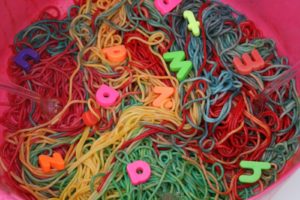Sensory exploration is essential for young children, as they learn through their senses. This is a perfect, taste-safe activity even for very young babies, who will delight in exploring the bin with their hands and feet.
There are so many things you can do with this particular sensory bin! I am planning to add other activities that use this beautiful rainbow spaghetti, so if you make it, store it until next week so you can use it for the new games! We use this sensory bin in all our classrooms at CEFA Early Learning schools, and the children love it. For a $1 box of spaghetti and a few drops of food colouring, your child will have hours of fun, and so many opportunities to learn through play. Look at the learning opportunities below.
Best Ages for This Activity
Zero to five, but older children will love it too and you might be tempted!
How to Make It
Ingredients
- Water
- 1 box of uncooked spaghetti
- 5 drops of food colouring for each colour that you want to make (you can make as many colours as you would like)
- 1 Ziploc bag for each colour that you want to make
- A sensory bin. Use anything you might already have at home. I like the ones with lids because they are easy to store and put away when you need (under the bed is the perfect place!). We use these bins for so many different sensory activities in the classrooms. If you do not have something to use around the house, you can purchase one here.
Let’s Get Started!
- Cook your spaghetti as you usually do. Once al dente, run under cold water to stop the cooking process.
- Divide the pasta so you can colour it, using one Ziploc bag per colour that you want to make.
- Add 2 tbsp. of water into each Ziploc bag of cooked spaghetti.
- Add 5 drops of food colouring to each bag – one colour per bag of pasta. You can add more colour if you prefer it more vibrant.
- Seal the Ziplock bag, mix the contents then leave for 5 minutes so the pasta can absorb the colour.
- Run the pasta in a colander under cold water until the water runs clear. The longer you wash it, the less likely the colour will run when playing.
- Shake off any excess water, then pat dry with a paper towel to remove any excess water.
- Add 1 tbsp. of oil (any oil you like) to the pasta to stop it from becoming sticky and stopping (as much as possible) the food colouring from staining hands during play.
- Your pasta is now ready for play! You can put it in the sensory bin for children to play with it on its own, and after a day or two, add kitchen gadgets, tongs or toys to further the play.
Learning Opportunities
Children will learn S.T.E.M. while making and dyeing the pasta, particularly math and science.
By helping you measure, mix, describe textures and colours, as well as the intensity of the colours as they get absorbed, they will be using math. As they are mixing and pouring, following all the steps, they are learning sequencing, which is great for reading as well as math.
Once it is ready to be played with, the soft spaghetti sensory bin will provide learning opportunities such as sensory play (a precursor to writing and other disciplines), colour recognition, dramatic play and fine motor skills.
Don’t forget to use math vocabulary such as:
- Measuring
- Volume
- Quantities (more than, less than, the same amount, 1 cup, etc.)
- Cold
- Cool
- Warm
- Colour
Describing while using vocabulary is one of the most important learning outcomes at this age. It teaches them reading and mathematics.
CEFA tip: Remember to let your child do as much of the process as they are capable of. This means they measure, mix and pour (not you). Except when it involves boiling water and fire, of course!
Things to Keep in Mind
Explore this sensory bin on the floor if possible, so children can use their hands and feet while playing.
Extended Learning Opportunities
- Use the pasta for dramatic play by inviting your child to play with it in a play kitchen, inside or outdoors, and watch as your child cooks, serves, and imagines all kinds of scenarios like a restaurant or a family dinner. This is a great activity for imaginary play, wither on their own or with friends.
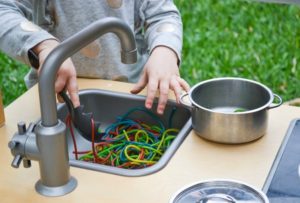
- Add tongs, grabbers or jumbo tweezers for your child to practice fine motor skills. Invite them to sort the pasta by colour, using the tweezers, to enhance their math learning.
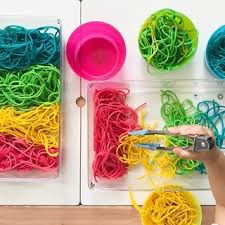
- Give your child a pair of safe scissors to practice their cutting and scissors skills using the spaghetti – very satisfying.
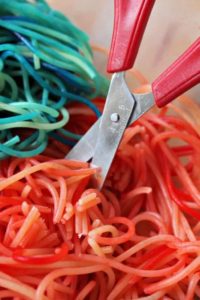
- If your child is too young to use tongs, hide some toys in the pasta for them to find and grab instead, which is how they will practice their fine motor skills.
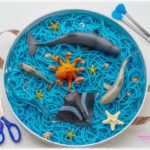
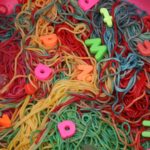
- Add letters for them to discover and name, for a fun reading activity.
